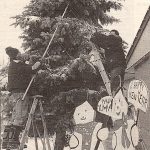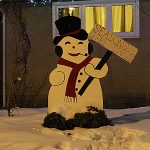Before Esther and Ron Matcham moved to Edmonton, the stretch of 148th Street between 92nd and 100th Avenue wasn’t much different from any other residential street in the city. Cozy postwar bungalows. Wide green lawns. Young trees, newly planted, not yet large enough to stretch their branches toward each other above the street or knit their roots together beneath its surface. But in 1968, a couple years after the Matchams bought a house halfway up the block, the sleepy little street began a tradition that would turn it into one of Edmonton’s most beloved landmarks.
Candy Cane Lane was born out of a casual conversation that Esther Matcham had with some of her new neighbours. Having moved from Saskatoon, which hosted a Christmas light competition every year, Esther asked whether Edmonton had anything similar. Upon learning that their new city was missing out, the Matchams got together with a group of neighbourhood families and decided to put on a lightshow of their own. Esther contacted the organizers of Saskatoon’s festival and got patterns for cutting out plywood snowmen, Santas, reindeer, and, of course, candy canes.
What began with a small group of families around 95th Avenue soon spread north and south along 148th Street, producing bigger and brighter displays and involving dozens of neighbours. The whole community embraced the idea—from Betty Androschuk, who let Boy Scouts set up a hot chocolate stand in front of her house; to Barbara and Jack Miles, who didn’t let the theft of their popular skunk decoration dampen their spirits; to Des O’Connor, who started giving his address as “9512 Candy Cane Lane,” even in the middle of summer.
One of the lane’s proudest promoters was Ken Luke, who’d lived on 148th Street since 1956. His home became known as the “Dear Old Dad House” after he set up a Christmas tree display with all the presents addressed “To Dad” (he’d joked with his family that they never gave him enough gifts, and decided he would treat himself). Ken changed up his extravagant lighting displays every year, helped older residents put up their decorations, and sweet-talked his neighbours into carrying on with their colourful tradition whenever their enthusiasm started to dim.
Candy Cane Lane grew throughout the ‘70s and ‘80s, with new families moving into the neighbourhood and getting into the spirit. One of the unspoken rules of the lane was to leave your plywood cut-out decorations in the garage when you moved, for the next family to use.
By the early ‘90s, Candy Cane Lane was attracting hundreds of thousands of visitors every year. The event grew so popular that it inspired another holiday-themed street—Halloween Alley—just north across the Mackinnon Ravine on 147th Street. After a visit to this spooky counterpart in 1993, Candy Cane Lane residents Aimee Branting and Lori Birchill had an idea.
Halloween Alley asked its visitors to bring donations for the Edmonton Food Bank, loading all the cans of tomatoes and boxes of mac-and-cheese into a hearse. In 1993, over just one night of trick-or-treating, Halloween Alley attracted 3,000 visitors and received 500kg of food. Candy Cane Lane lasted for three weeks and regularly saw upwards of 300,000 visitors—and Branting and Birchill saw an opportunity.
The Food Bank was initially skeptical if visitors would be as likely to donate at Candy Cane Lane as they were on Halloween Alley, since they had never held a food drive at an outdoor winter festival before—let alone one that lasted three weeks. But they provided boxes for Branting and Birchill, who gave them out to all the neighbours along the lane who were willing to participate. They expected to collect a couple shopping carts worth of food.
“In the early evening on the first night, Lori and I had calls from the residents: ‘My boxes are full,’” remembers Branting. “It was overwhelming and exciting at the same time. Yvonne Bootsman’s home at 97th Street was the first house people saw. She had over 365 kilograms of food that she brought in to her house. She had bags of food in her living room, down the hall and into the bedrooms.”
They collected more than 900kg on the first night, and more than 22,000kg over the course of three weeks, when 400,000 people came to see the lights. It was 20% of all donations to the Food Bank that month, and it solidified Candy Cane Lane as the winter equivalent of the Heritage Days food drive in August. Over the years, the donations have wavered with the weather—from a low of 9,000kg in the icy cold winter of 2008, to a high of 31,000kg in the mild Christmas season of 2011. On December 11, 2015, Candy Cane Lane’s total contributions to the Food Bank surpassed one million pounds.
There have been calls for Candy Cane Lane residents to be repaid for their tremendous generosity: “It’s time for the city of Edmonton to start giving back to Candy Cane Lane,” declared repeat visitor V.O. Morrison in a letter to the editor, proposing that the city subsidize 148th Street’s power bills in December. Some residents agreed with this proposal, and in 2003 city council explored the possibility of subsidizing their power costs, but ultimately voted against it. Ask any lane resident their biggest pet peeve and they’ll name the persistent myth that they’re somehow compensated by the city.
“We do it just for the sheer enjoyment of other people,” said Esther Matcham in 1989. “The buses that go by, the look of happiness on the children’s faces. I think what we’re doing is creating memories for people.”
And so they have. Multiple generations of neighbours have kept the tradition alive, each person contributing in their own unique way. From Liz Iverson, who moved to Candy Cane Lane from Halifax without knowing its yuletide tradition, to Max Rossetti, who moved his family to 148th Street specifically to live on the Lane. From Sheila Rooks, who was an early converter to energy-efficient mini bulbs, to Sandra Strangman, who found “anti-Santa rhetoric” and severed doll thumbs on her doorstep from a disturbed lane goer. From Crystal Glister, who kept a firepit going at night so people could stop and warm up, to Paulette Pewarchuk, who always turned her lights back on for people when they rang her doorbell late at night, saying they’d come a long way.
Candy Cane Lane has welcomed visitors from around the world and from across the city. Joanne Colleaux and her husband showed off the Christmas displays to Chinese international student Yi Ping when they hosted him on exchange. Fijian visitor Sabita Prasad came to see the lights with her family after ophthalmologist Linda Uniat restored her vision, which had been destroyed by diabetic retinopathy. Children from Edmonton’s hospitals, teens from the Youth Emergency Shelter, and seniors from nursing homes have all found comfort and joy in the twinkling lights. They, like countless other Edmontonians, have treasured memories and cherished traditions along this inauspicious stretch of road—stories of kisses and arguments and snowball fights, of wide-eyed kids and warm-hearted seniors. And all of them are part of the story of Candy Cane Lane.
Sources:
“Foreign students visit homes; 20 host families needed; Foreign-student visits cost nothing but time.” Smith, Sharon. Edmonton Journal. 18 June 1989: N3.
“Candy Cane Lane an annual tradition.” Bartlett, Cathie. Edmonton Journal. 10 Dec 1989: E5.
“LETTER OF THE DAY.” Edmonton Journal. 19 Jan 1990: A15.
“Candy Cane Lane founder dies at 71.” Gilmour, Bob. Edmonton Journal. 11 Aug 1990: C4.
“Frigid temperatures set to drop on Edmonton’s trick or treaters; Malls opening doors for a warm alternative.” Edmonton Journal. 31 Oct 1991: B1.
“Glory of Christmases past, present; Candy Cane Lane puts neighborhood on the map.” Bartlett, Cathie. Edmonton Journal. 05 Dec 1992: G2.
“Candy Cane Lane light show set to welcome up to 400,000.” McConell, Rick. Edmonton Journal. 11 Dec 1992: B3.
“Halloween treat for Food Bank.” Marani, Michelle L. Edmonton Journal. 06 Nov 1993: A13.
“Bright lights will help feed hungry.” Panzeri, Allen. Edmonton Journal. 02 Dec 1993: D15.
“The hungry can bank on Candy Cane Lane.” Engman, Kathleen. Edmonton Journal. 06 Dec 1993: A1.
“Candy Cane Lane fans generous with food gifts.” Henderson, Ross. Edmonton Journal. 14 Dec 1993: B3.
“Candy Cane Lane fills food bank shelves.” Henderson, Ross. Edmonton Journal. 18 Dec 1993: B2.
“Candy Cane Lane spirit helps food bank.” Aikenhead, Sherri. Edmonton Journal. 28 Dec 1993: B1.
“Candy Cane lane helps food bank set Dec. record.” Edmonton Journal. 28 Dec 1993: A1.
“Candy Cane Lane food drive shows true meaning of Christmas.” Arnold, Tom. Edmonton Journal. 03 Jan 1994: B1.
“Halloween Alley all tricked out for a ghoulish good time.” Chambers, Allan. Edmonton Journal. 27 Oct 1997: A1.
“Edmonton trips the lights fantastic Candy Cane Lane may not appear on city maps, but everyone knows where to find it.” Laghi, Brian. The Globe and Mail. 19 Dec 1997: A2.
“Big hearts, busy hands brighten a stranger’s day.” Mah, Bill. Edmonton Journal. 23 Dec 1997: A1.
“Candy Cane Lane’s brightest light missing from this year’s spectacle; A Glittering Tradition.” Cooper, Mitch. Edmonton Journal. 13 Dec 1998: A7.
“A sight to behold; MDs waive fees to give Fijian woman a very special gift.” Exner, Raquel. Edmonton Journal. 24 Dec 1998: B1 / Front.
“Electricity costs may take shine off of Christmas.” Hryciuk, Dennis. Edmonton Journal. 20 Nov 2000: B1 / Front.
“Spirits bright despite power costs: Candy Cane Lane residents aren’t cutting back on holiday bulbs.” Brooymans, Hanneke. Edmonton Journal. 07 Dec 2000: B11.
“It’s all about awe, not power bills.” Thomas, Don. Edmonton Journal. 15 Dec 2002: A9 / Front.
“Lane life brightens Christmas, lightens wallets.” Howell, David. Edmonton Journal. 15 Dec 2002: A1 / Front.
“Edmonton gets the benefits while residents foot the bill.” Morrison, V O. Edmonton Journal. 21 Dec 2002: A19.
“Unable to scare up support, Halloween Alley calls it a night.” Sinnema, Jodie. Edmonton Journal. 28 Oct 2005: B3.
“Newcomer to Candy Cane Lane an instant convert: Mayor lauds community spirit of residents.” Sinnema, Jodie. Edmonton Journal. 10 Dec 2006: A16.
“Tradition of Candy Cane Lane lives on in sweet memories; Decorating homes showed community spirit, recalls one of the founders, now 93.” Gold, Marta. Edmonton Journal. 19 Dec 2010: A4.
“Grinch pays a visit to Candy Cane Lane.” Wittmeier, Brent. Edmonton Journal. 28 Dec 2010: A2.
“Candy Cane Lane prankster won’t be charged.” Edmonton Journal. 31 Dec 2010: A8.
“Resident vows to keep Candy Cane Lane sweet, simple; No place for commercialism, enthusiast says.” Otiena Ellwand. Edmonton Journal. 16 Dec 2013: A3.
Bruce Cinnamon © 2016







